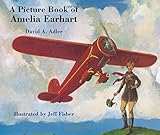Lesson 3: Tells a Story
Lesson Plan
A Picture Book of Amelia Earhart | 880L

- Learning Goal
- Explain that a biography tells a story.
- Describe the story of a person’s life from a biography.
- Duration
- Approximately 50 minutes
- Necessary Materials
- Provided: Unit Example Chart, Independent Practice Worksheet
Not Provided: A Picture Book of Amelia Earhart by David A. Adler, chart paper, markers
-
Teacher Modeling

will explain that another characteristic of a biography is that it tells the reader a story. Instead of telling readers a collection of facts, like in an informational book, a biography tells readers the facts of a person’s life in a story form, usually with a beginning, middle, and end. I will add the characteristic, “Tells a Life Story” to my Characteristics of Biographies Chart that I started in Lesson 1 (example provided). A good reader can identify and describe what happened at the beginning, middle and end of a person’s life by identifying the events in a biography. I will read aloud the beginning of the biography, A Picture Book of Amelia Earhart by David A. Adler. I will look for events in Amelia’s early life to help me describe the beginning of the story. I will add a sentence to the chart describing the events in the beginning of her life. I will retell the beginning of her life by saying, "Amelia Earhart was born in Kansas. She was a smart girl who liked to get messy. When she saw her first airplane, she was not very interested in flying."
-
Think Check
Ask: "How do I describe the life story of the real person whom a biography is about?" Students should respond that you should identify the events in the beginning, middle, and end of the biography, and use them to describe what happened in the person’s life.
-
Guided Practice

will continue reading the biography, A Picture Book of Amelia Earhart. While we read, we will identify events that will help us describe what happened in the middle of Amelia’s life. We will then use those events to describe the middle of her life. We will discuss how this information is told to us as a part of a story and add the title of the book to our chart to show how this biography tells a story. We will finish reading the biography.
-
Independent Practice

will describe the end of Amelia Earhart’s life by drawing a scene from the end of the biography and telling the class what happened in Amelia’s life . You will share your illustration, and help the class think of a description of what the story was about to add to the chart. On your worksheet, you will explain how you know the book is a biography. (Independent Practice Worksheet is provided.)
Texts & Materials
Standards Alignment
(To see all of the ReadWorks lessons aligned to your standards, click here.)

